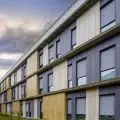A {tag:studenci} from the West Pomeranian University of Technology from Szczecin, in his "Art of the Shore" project, proposed the expansion of the Szczecin Academy of Art. It is an idea for revitalizing waterfront brownfield sites.
axonometry
© Mateusz Nisiewicz
revitalization
Today, in an era of many economic, social and environmental crises, revitalization is becoming the most important issue of current architectural and construction development. The rich heritage of historical, industrial buildings in degraded areas is a valuable architectural fabric, often unfortunately neglected and deteriorating due to poor management of such space or the usual reluctance to revitalize these areas at the expense of building more and more new facilities. Properly carried out revitalization of degraded coaches positively affects the urban environment, increases the biodiversity of the city, integrating local and supra-local communities, which increases public participation and involvement in the process of planning further revitalization activities.
elevation
© Mateusz Nisiewicz
design concept
The project is an attempt to revitalize and activate the degraded space at 61 Kolumba Street in Szczecin, through the introduction of an attractive architectural form of a new building and the adaptation of an existing historic tenement house. The project consists of an urban planning concept, architectural concept, conservation concept and elements of interior architecture concept.
visualization
© Mateusz Nisiewicz
new building
The building is a free-standing form, bordered by two structures: on the Oder side with the brick building of the former yeast factory F. Crepin, and from the courtyard with a historic 19th-century tenement house. The form of the building is curved, referring to circular elements such as the brick chimney of the former factory and the characteristic turret at the historic tenement. The facade of the new building was designed with a contemporary reinterpretation of the facade of the F.Crepin yeast factory in mind. An arched high glazing was used in the ground floor, giving lightness to the form and referring to the detail of the arch present on the factory's facade. In the upper floors, keyed razor blades were used, providing optimal lighting conditions for the interiors.
visualization
© Mateusz Nisiewicz
historic tenement
The existing tenement house was adapted for a new function related to art education, connected by an underground tunnel providing communication with the newly designed building. The tenement was rebuilt with a staircase and the spatial layout was slightly altered by introducing new partition walls.
entrance
© Mateusz Nisiewicz
landscaping
The designer wanted to create a space accessible not only to students of the Academy of Arts, but also to city residents. By moving the newly designed building away from the historic tenement, an intimate public space of the inner courtyard was created. Circular bencheswith space for greenery were placed in the courtyard. Taking advantage of the waterfront qualities of the site, a wooden terrace was designed with a streamlined shape referring to the form of the new building.
first floor
© Mateusz Nisiewicz
pro-environmental solutions
Pro-environmental bonds are important in the facility, promoting better functioning of the space and contributing to the reduction of CO2 emissions. In addition, they reduce the heat island in the city. In the interiors, wooden functional design elements were used: cabinets, tables for learning and workshop activities. Designing a green wall on the building's blind facade, in turn, promotes the city's biodiversity. In addition, the project uses photovoltaic panels on the roof and recuperation with heat recovery.
interior
© Mateusz Nisiewicz
The expansion of the headquarters of the Academy of Art in Szczecin is a synergy of new and old. It harmoniously connects the two buildings while creating an interesting and open public space around it. The project is a response to the revitalization problems of Szczecin's attractive post-industrial waterfront space.
gallery
© Mateusz Nisiewicz



















































